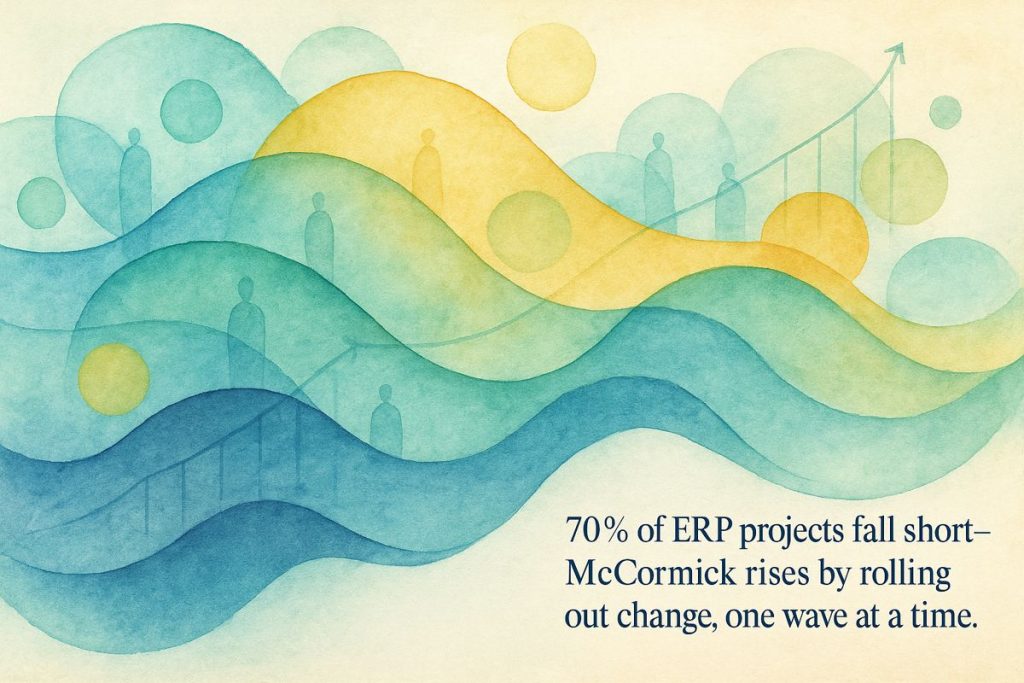McCormick is upgrading its business software (ERP) step by step, not all at once, to avoid big problems and keep things running smoothly. They start with one area, like finance, then move to others, learning and fixing issues as they go. This careful approach helps control costs and reduces risks, making sure spices keep moving around the world. The company also focuses on training their people well, mixing new technology like AI into their plans for a tastier, smarter future.
Why is McCormick implementing its ERP upgrade in phases instead of all at once?
McCormick is phasing its ERP upgrade to SAP to manage risk, control costs, and ensure smoother transitions. By rolling out modules like finance and supply chain one at a time, the company can address issues early, refine processes, and keep global operations stable and efficient.
Prelude: The Scent of Change in the Air
It smells, oddly enough, like cinnamon and anticipation. That’s what I remember from a planning meeting at McCormick & Company’s Baltimore campus—right before someone spilled their robusto espresso on the Gantt chart. You’d think global flavor manufacturing would be immune to the blandness of enterprise IT, but here we are: McCormick is overhauling its ERP system, and the stakes are spicier than their Sriracha blend.
As the world’s preeminent steward of spices (move over, Penzeys), McCormick’s ambitions echo like a cathedral bell through the marble halls of SAP’s headquarters. But why phase the rollout? Why shun the infamous “big bang”? Consider: Gartner has pegged the failure risk for large ERP projects at nearly 25% by 2027—a statistic that’s haunted more than one CIO’s dreams (CIO Dive report). Even the mighty Clorox bore scars from going too fast, too soon.
I’ll admit, I once thought ERP upgrades were bureaucratic molasses. Then I watched a supply chain dashboard blink out in Shanghai, and—bam!—half a continent waited for paprika. Lesson learned.
Phased Deployment: Unspooling Complexity, Thread by Thread
McCormick’s chosen path? Slow and steady. They’re rolling out SAP’s gleaming modules one functional area at a time, an approach reminiscent of a palimpsest—layers of the old system fading as the new is meticulously inked in. First, finance; next, supply chain; then sales, each domain getting its moment under the hyperspectral scrutiny of test teams.
The rationale? It’s not just technocratic caution. By 2027, McCormick expects to have spent up to $350 million on this odyssey, with yearly outlays trickling between $35 million and $50 million (Digital Commerce 360, Supply Chain Dive). That’s not pocket change, and it’s doled out like a careful barista measuring the grind. But the real reward? Synchrony. You can almost hear the click of standardized workflows—globally, from Guangzhou to Geneva.
Risk is corralled this way. Instead of a cliff dive, there’s a winding road down the mountain. Each module’s rollout becomes a micro-experiment, lessons learned folded into the next phase. I had to stop and ask myself: could this approach become the new industry zeitgeist? Or is it just risk aversion dressed as strategy?
Leadership, Learning, and the Human Factor
Enter Guy Peri, McCormick’s Chief Information and Digital Officer (the title alone feels like it should have its own acronym). Peri joined late in 2024—fresh from Procter & Gamble, bringing a whiff of AI and digital bravado. It’s his job to keep the ERP train rolling without derailing McCormick’s broader digital innovation agenda (CIO Dive).
Peri’s mantra? Plan meticulously, train obsessively, document religiously. There’s something almost Talmudic about their approach: every workflow scrutinized, every employee nudged into readiness before the next domino falls. Staff engagement isn’t a box to check—it’s the yeast in the dough. I’ll confess, I once underestimated the power of a single skeptical warehouse manager (never again).
The emotional tenor? Equal parts anxiety and curiosity. When McCormick China rolled out SAP modules with a consulting partner, you could sense the tension—like the crackle of static before a thunderstorm (Instagram reference). Yet, post-launch, those tense frowns often yield to relief and even pride.
The Grand Synthesis: ERP, AI, and the Road Ahead
Here’s the kicker: McCormick isn’t freezing innovation while the ERP saga unfolds. Far from it. Even as legacy systems are swapped for SAP’s glittering architecture, the company pours resources into artificial intelligence—chasing optimization, ferreting out efficiencies, and, perhaps, conjuring flavor algorithms no human palate could envision (Digital Commerce 360).
The early returns? Sales and net income ticked upward in Q2 of 2025. Some of that, the company claims, owes to newfound digital agility (McCormick IR). It’s not alchemy—just the fruit of thousands of incremental improvements, each small, each hard-won.
I’ll close with this: in enterprise IT, perfection is a mirage. Flaws lurk in every corner, documentation will always need one more revision, and someone—always—will forget their SAP password. That’s the human side of transformation, and honestly…it’s kind of comforting.
For further reading, the links above are your breadcrumb trail. Don’t say I didn’t warn you about the espresso.
